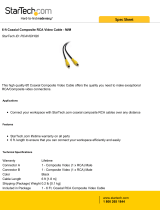Page is loading ...

8495 Dalton Road, Mount Royal, Quebec, Canada. H4T 1V5
Tel: (514) 905-0588 Fax: (514) 905-0589
Toll Free (North America): (877) 689-5228
E-mail: [email protected] URL: www.muxlab.com
© MuxLab Inc. 94-000634-B SE-000634-B
Specifications
Environment
Component Video (YPbPr), RGB Video (sync on green). 480i/p, 720p,
1080i/p. Line level Composite Video (NTSC, PAL, SECAM).
Devices
DVD players, satellite receivers, plasma displays, projectors, monitors,
up-converters, amplifiers, switchers, home theatre and other equipment
supporting HDTV component video and/or Composite Video.
Transmission
Transparent to the user
Bandwidth
Component: 60 MHz, 3 dB roll off
Composite: DC to 8 MHz
Maximum Input
1.1 Vp-p
Insertion Loss per
Pair
Component: Less than 3 dB per pair over the frequency range.
Composite: Less than 2 dB per pair over the frequency range.
Return Loss
Greater than 15 dB over the frequency range
Common Mode
Rejection Ratio
Component: -55 dB max.
Composite: Greater than 40 dB at 8 MHz
Max. Distance via
Cat 5E/6 UTP/STP
Cable
480i/p: 1,000 ft (305 m)
720p and 1080i/p: 500 ft (152 m)
Composite Video: 2,200 ft (670 m)
Cable:
Cat 5E/6 UTP/STP
24 AWG or lower solid copper twisted pair wire
Impedance: 100 ohms at 1 MHz
Maximum capacitance: 20 pf/ft
Attenuation: 6.6 dB/1,000 ft at 1 MHz
Cable: Coax
Impedance: 75 ohms at 1 MHz
Connectors
500056: Three (3) RCA-M connectors: Green (Y), Blue (Pb), Red (Pr)
500057: Three (3) RCA-F connectors: Green (Y), Blue (Pb), Red (Pr)
One (1) RCA-F connector for Composite Video
RJ45S for twisted pair
Pin Configuration
Reverse polarity sensitive
Red (Pr): Pins 7(R) & 8(T) Green (Y): Pins 3(R) & 6(T)
Blue (Pb): Pins 1(R) & 2(T) Composite Video: Pins 4(R) & 5(T)
Temperature
Operating: 0° to 55°C
Storage: -20° to 85°C
Humidity: Up to 95% non-condensing
Enclosure
ABS fire retardant plastic
Dimensions
500056: plus 6” (15 cm) cable lead for video
500057: 2.40” x 2.25” x 1.00” (6.10 x 5.72 x 2.54 cm)
Weight
2.6 oz (74 g)
Regulatory
FCC, CE, RoHS
Warranty
Lifetime
Order Information
500056 Component/Composite Video Balun, M
500057 Component/Composite Video Balun, F
Component / Composite Video Balun
500056, 500057
Quick Installation Guide
Overview
The Component/Composite Video Balun (500056, 500057) allows one component
video (YPbPr or RGB) signal and one composite video signal to be transmitted via a
cost-effective unshielded twisted pair (UTP) cable.
Used in pairs, the Component/Composite Video Balun supports 480i/p, 720p and
1080i/p resolution for hi-definition (HDTV) video applications.
The product allows four coaxial cables to be replaced by one Category 5E/6 twisted pair
cable, enabling standard structured cabling techniques to be used for more efficient
cabling.

© MuxLab Inc.
Installation
One (1) pair of baluns is needed to complete one component/composite video connection
via a Cat 5E/6 twisted pair. To install the baluns, perform the following steps:
1. Identify the pin configuration of the baluns. Three (3) twisted pairs are required for
video and one (1) twisted pair is required for optional Composite video. The pin
configuration follows the EIA/TIA 568A/B standard. The Component/Composite
Video Balun is reverse polarity sensitive. Please ensure that wiring is straight-
through (Ring to Ring, Tip to Tip).
2. Plug one (1) balun into the component video coaxial cable output of the video
source according to the color code of the RCA cable leads.
3. Plug the second balun into the component video coaxial cable input of the video
screen or receiver at the remote end.
4. Complete the connection between the two baluns, using a standard Cat 5E/6
twisted pair cable and connecting hardware, terminated on RJ45 plugs at both ends.
Ensure that there are no split pairs or taps.
5. If Composite Video is to be connected (optional), connect an RCA lead between
the balun and the Composite Video equipment at both ends.
6. Power-on the component video equipment. Check the image quality and refer to
the troubleshooting table below if the image quality is unsatisfactory. The
following diagram shows a typical installation.
Troubleshooting
The following table describes some of the symptoms, probable causes and possible
solutions in respect to the installation of the Component/Composite Video Balun:
Video Symptom Probable Causes Possible Solutions
No continuity in video link Verify cable continuity between pairs of baluns.
Power off Check power supplies of video equipment.
No video
Improper connection
and/or swapped pair
Check that baluns are connected to correct video
inputs and outputs.
Unusual colors Reversed polarity
Check wiring and ensure straight-through
polarity
Background pattern EMI interference
Identify possible radiating frequency sources
(i.e., wireless LANs, switching power supplies).
Try to isolate them from the video connection.
Use shielded twisted pair grounded at both ends.
Smearing Exceeded distance
Verify cable grade. Use higher grade cable if
necessary.
Exceeded distance
Verify cable grade. Use higher grade cable if
necessary. Increase contrast on monitor.
Weak contrast
Unusual link attenuation
Verify cable distance using ohmmeter or cable
tester.
Image not stable
Defective link or
equipment
Verify video equipment interface integrity.
Horizontal bars
moving slowly
Substantial crosstalk
between multiple video
sources
Consecutively turn off other video sources to
determine which video source is the cause of
interference.
Snowy picture Distance is near limit
Verify cable grade. Use higher grade cable if
necessary. Reduce color intensity at monitor.
If you still cannot diagnose the problem, please call MuxLab Customer Technical
Support at 877-689-5228 (toll-free in North America) or (+1) 514-905-0588
(International).
/










